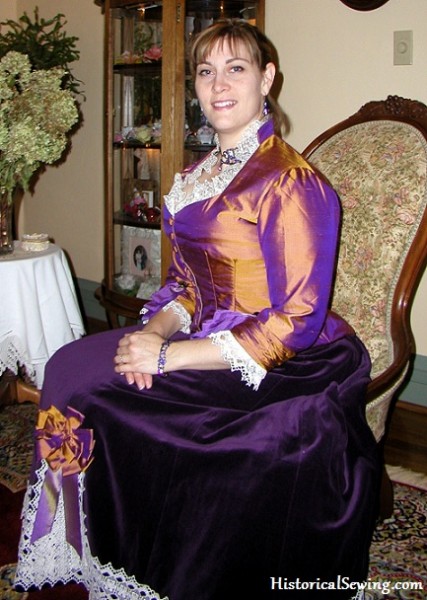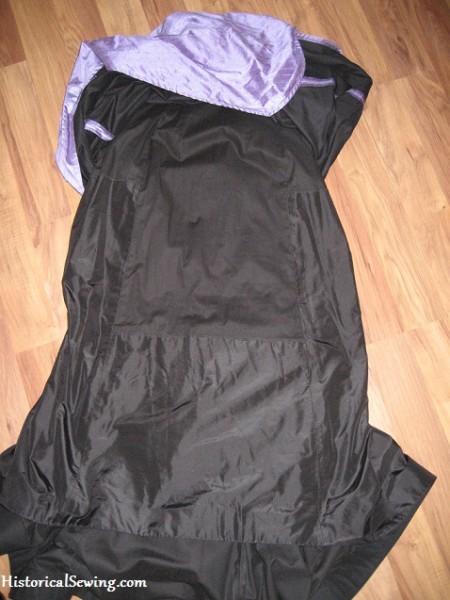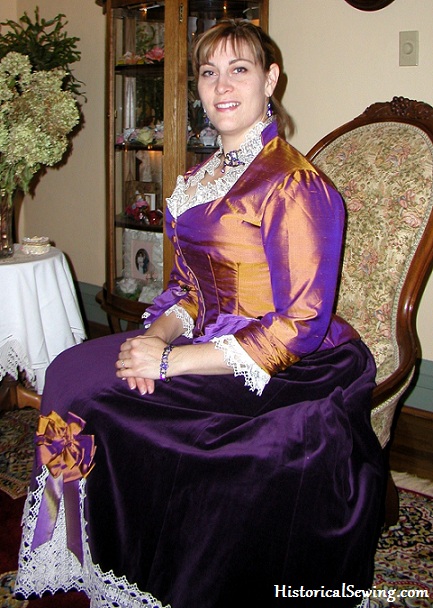
Do you love cotton? You already know I do. In fact, many of my costumes get their start from a cotton textile and my historical garments have at least one cotton material in them. This is true for all of them – especially those poufy bustles of the 1870s and 80s.
The base for all awesome bustle dresses is the foundation skirt, sometimes called an underskirt. When you start with a cotton base, you’ll have a firm support to throw all those fancy trims and ruches and ruffles upon. The cotton underskirt also helps stabilize itself on the petticoats and wire support.
I heartily recommend 100% cotton for your bustle costume base.
However there are some natural fiber blends available that work just as well, like cotton/linen (soft hand) and cotton/silk (can be stiff and difficult to sew as well as warm). Remember to check the end of bolts or do a burn test with a swatch(outside of the store!).
Below are appropriate cottons I recommend for your gorgeous bustle dresses.
Cotton Fabrics to Use When Mounting Fancier Fashion Fabric to the Skirt

You’ll want a sturdy fabric whenever you mount something on top of it, whether that be a silk or simply rows of 4″ fringe. Many of my more intricate bustle skirts have a foundation skirt that then get decorated on top. Here are cotton fabric suggestions for a successful underskirt to support that fancy design.
- Twill
- Lightweight denim
- Firmly-woven polished cotton
- Home dec lining (like Rain No Stain at chain fabric stores)
- Poplin
Cotton Fabrics for Stand-Alone Foundation Skirts

Sometimes you’ll find a gorgeous cotton print that just demands it be seen. Add a little pleated ruffle to the bottom and voila! a quick and easy underskirt. Check out the delightful printed bustle dresses in the Victoria & Albert Museum or the book Nineteenth Century Fashion in Detail for inspiration.
- Dotted Swiss
- Quilting fabrics in solids or prints
- Calico prints with a solid hand and not much drape
- Corduroy
- Velveteen
- Sateen
- Cotton moiré
Cotton Fabrics for Summer Wear Underskirts
Even when making a sheer bustle gown, I strongly recommend making a lighter-weight foundation skirt, even in twill or poplin, then flatlining a lighter fabric over it. The strong base under the flowing overskirts will smooth out the top layer of petticoats and set the perfect silhouette.
If your top petticoat works well as a foundation type of skirt, then by all means tackle that underskirt in one of these delicate fabrics.
- Organdy
- Printed lawn
- Dimity (shirting fabric)
- Eyelet
- Voile
Whether worn alone or with mountains of overskirts, a good cotton underskirt will help support that lovely bustle silhouette. Be stylish, period appropriate and comfortable!
Do you consider your foundation skirt when making a bustle dress? Have you used cottons for them?


I’m curious to know if the Victorians would ever mix fabrics in an ensemble. For example, if they had a silk taffeta bodice and bustled overskirt, would they ever wear a cotton underskirt or would it also be made of silk?
Yes, they would but there are some “rules” to this. For a cotton dress use cotton or silk to trim. I wouldn’t recommend a cotton overskirt over a silk underskirt, but you might get away with the other way around if you trim the cotton underskirt with the same silk you use for the bodice. Cotton sateen is a nice compromise as it’s got a sheen and will blend better with silk. If you have a linen dress, don’t trim in silk but in linen or cotton. And don’t trim a silk skirt, ever, with cotton. If a silk dress, trim with silk. Wool dresses can have silk or cotton trim but take note that the cotton used is not inferior. Hope this helps!
What do you mean by ” flatline”? I’m in the process of making my first historical outfit. I recently moved to Tombstone, AZ and having the appropriate attire is a must here. I have been sewing for oer 50 yrs. And I have always wanted to make a bustle dress. Finally I am really going to do it. I really like your site here, it is so informative.
Hi Linda – Good for you on making your first historical costume! It’s so much fun. Good luck with yours. For flatlining, read this article. It pertains to bodices but the idea is the same for skirt panels. You will flatline each panel separately with an underlining fabric then treat it as one piece for the rest of construction.
This has answered a few questions. Having not made a bustle ensemble before I’m bemused and befuddled by what foundations are needed and in what order. lol!
I’m not sure I understand what you mean by “foundation skirt” in this article. Is it a skirt that is worn stand alone with a variety of decorated skirts over it? Is it a plain base to mount your fashion fabric and trimmings onto, similar to underlining? It also appears you can have a foundation skirt that is undecorated in a printed calico… I do wonder if I’m understanding this correctly!
You are thinking correctly! The foundation skirt for a bustle dress, also called the underskirt, is the first long layer of the dress worn right on top of the petticoats. It can be worn alone or topped with various overskirts and aprons. It can also be made from a base fabric such as the twill cottons I mention here then a fancy fashion fabric flatlined on top.